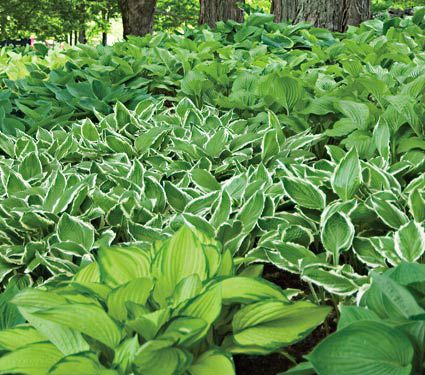






Hosta
Divas of the shady garden, Hostas provide rich textures and elegantly patterned color with their bold foliage, plus spikes of flowers in midsummer. Not surprisingly, Hostas are addictive, which should cause concern given that there are 3,000 to 4,000 different varieties registered with the American Hosta Society. One could overdose, or at least blow a major hole in the horticultural budget.
As with any class of plants, however, not all Hostas are created equal. Over the last five decades we have tried and rejected quite a few. In the process, though, we've identified what we believe are the essential Hosta varieties. This choice selection includes both tried-and-true classics and the best of the new. All our Hostas are reliable, hardy plants that, given reasonable care, should flourish almost anywhere from zone 3 through zone 8 or 9, which encompasses most of the continental United States.
The Right Hosta for You
The difference between Hostas is more than just a matter of appearance. Some of our selections, for example, only thrive in shady locations while others will tolerate full sun if kept well-watered. Some, such as 'Thunderbolt', 'Blue Ivory', and 'Hadspen Blue' are naturally resistant to slugs, which have an appetite for Hosta foliage. In general, Hostas find the combination of high heat and humidity characteristic of the southeastern states trying; some varieties (notably 'Blue Mouse Ears', 'Magic Fire', and 'Thunderbolt') tolerate that condition better than others. A few, such as Hosta plantaginea 'Venus' bear fragrant flowers.
Hosta Growing Tips
Hosta - How to Care for Your Plant
Light/Watering: Drought-tolerant once established, these plants are at their best in evenly moist soil in partial shade, although a very few will tolerate full sun with sufficient water. Once established, Hostas can take a good bit of drought, and will compete successfully with tree roots in the North, but need regular watering in the South.
Fertilizer/Soil and pH: Hostas thrive in average, even damp, soils that are slightly acid and will benefit from a light application of fertilizer in early spring. These low-maintenance plants can be ignored and they will still perform; to get the most out of them, however, provide deep, rich soil and consistent watering along with occasional side-dressing of compost or aged manure. An organic mulch is appreciated but keep it away from the crowns.
Pests/Diseases: Slugs are the bane of Hostas; use slug bait, dishes of beer, and diatomaceous earth to discourage them. Voles have been known to decimate plantings by eating the roots; trap or use another method to repel these varmints.
Companions: Hostas are lovely with other shade-lovers such as Ferns, Tiarella, taller Campanulas, Phlox divaricata, Daylilies and, especially, true Lilies. They are ideal when planted amid patches of spring-flowering bulbs, as their foliage will obscure the bulb foliage as it dies back.
Reflowering: Very few varieties will reflower; cut flower spikes off at their base when blooming is over.
Dividing/Transplanting: These forgiving plants are best divided in spring when the new leaves are still furled up, but both division and transplanting are successful throughout the season if attention is paid to thorough follow-up watering.
End-of-Season Care: Foliage should be cut back in the fall to eliminate cover for overwintering slugs but this can also done in the spring.
Calendar of Care
Early Spring: Apply a light application of balanced or slow-release fertilizer or side-dress with compost and organic amendments when new growth appears. Divide or transplant now before leaves unfurl. Water newly planted plants well if it is unseasonably dry, as Hostas prefer evenly moist soil.
Mid-Spring: Mulch plants after soil has warmed, keeping mulch away from the crowns to discourage rot.
Late Spring: Watch for slug damage and use preventative measures if slugs are active.
Summer: Groom plants by removing yellow or dead leaves and cut flower spikes back as they finish blooming, unless you want to collect seed.
Fall: Cut foliage back to soil level. For new plants, provide a winter mulch of evergreen boughs or salt marsh hay after the ground freezes to help prevent heaving.
Copyright © www.100flowers.win Botanic Garden All Rights Reserved